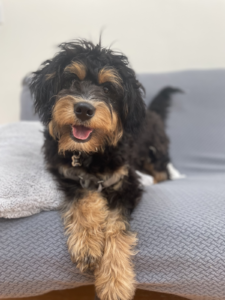‘Tis the season that keeps on giving! So why not learn what rewards to give your dog?
One of the most crucial things pet parents attempt to understand is how to motivate their dog to want to follow cues or learn to do new things! The goal of any dog training session is to encourage more desirable behaviors from our pups, especially when we ask it of them. Generally speaking, praise and other rewards can motivate our dogs to continue those desired behaviors so we see more of it more often.
Unfortunately, there is no “one size fits all” answer to this question. YOU as their human don’t get to decide what the best motivation for your dog will be but it is your job to find out exactly what it is.
Four of the Most Common Motivators for Your Dog
🐾 FOOD. Food is a very valuable “paycheck” for dogs during training and is a great motivator for most dogs. Food is something that dogs instinctively know is awesome and want to get more of, regardless of their breed or age. It is important to not become singularly reliant on only getting responses when food is visible. Food rewards can range from your dog’s basic kibble that they eat for their meals, or more high-value rewards, such as cheese or hotdogs. Tailoring the type of food reward to the activity and difficulty of the training session will help you remain successful!
➡️ A stressed or anxious dog may not take food when nervous or overstimulated, this is often a good indication that the environment isn’t conducive to learning right now.
🐾 WORDS & PRAISE. Giving your dog a marker word or sound, such as a clicker or “good!”, and responding to them with positive enthusiasm can strengthen their desire to work or return to the behavior. Ask yourself if your dog seems like they’re having fun, changing your behavior to encourage them to act a little more silly and have more fun engaging with you is key! If you’re communicating to them that they’re doing well and you’re having a good time it’s more enjoyable for everyone!
➡️ If you find yourself getting frustrated, take a second to decompress, training while stressed can lead to more mistakes and less fun for everyone.
🐾 PLAY. For some dogs, playing is better than eating (or at the very least just as good as eating!) The one-on-one attention your dog gets from you through playing is a great reward and can strengthen your relationship and bond. It’s something where you both participate together as a team. Some dogs prefer the game of tug and drop and others may find more interest in chasing a ball but all play is good play so long as your dog is motivated to continue working between play sessions!
➡️ This is great for most higher-drive dogs who desire to chase or tug and engage more with movement!
🐾 AFFECTION. There are dogs out there that just want to be touched! Some pups even prefer petting over vocal praise! Taking a moment to give your dog some love between them working and training with you is a great way to build up positivity around cues! It is important to make sure that our physical affection is welcomed by our participant and to give regular breaks between touch to allow our dogs a chance to move away if they so choose!
➡️ Understand that dogs differ in their touch sensitivity, meaning, where and how they like to be touched can be vastly different depending on the dog!
All of these can be mixed and matched together as rewards to keep things engaging and interesting for everyone! Who knows, if you’re creative enough you may even find something that you didn’t expect could be motivating for your dog! You might even find that different environments may call for different reinforcements, what works one day or in one place might be different upon a revisit.
Final factors to consider when rewarding your dog
Timing: Timing is absolutely everything when using rewards with our dogs. The reward should occur almost immediately, within just a few seconds, or your dog may not associate it with the proper action.
Consistency: Make sure that everyone in the household is using the same cue language, otherwise, your dog may become confused. It is also important that everyone is on the same page about the expected behavior criteria. (ie. when your dog lays down you want them to go all the way to the floor, not just stop and hover above the ground.)
Rewards are a great way to keep training fun and enjoyable for both yourself and your pooch. So, get out there and start experimenting with what rewards make your dog’s tail wag and brain work!




